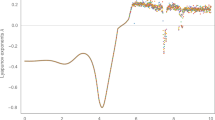Abstract
A fundamental link between system theory and statistical mechanics has been found to be established by the Kolmogorov entropy K. By this quantity the temporal evolution of dynamical systems can be classified into regular, chaotic, and stochastic processes. Since K represents a measure for the internal information creation rate of dynamical systems, it provides an approach to irreversibility. The formal relationship to statistical mechanics is derived by means of an operator formalism originally introduced by Prigogine. For a Liouville operator L and an information operator\(\tilde M\) acting on a distribution in phase space, it is shown that i[L,\(\tilde M\)]≡KI (I=identity operator). As a first consequence of this equivalence, a relation is obtained between the chaotic correlation time of a system and Prigogine's concept of a “finite duration of presence.” Finally, the existence of chaos in quantum systems is discussed with respect to the existence of a quantum mechanical time operator.
Similar content being viewed by others
References
H. Haken,Synergetics—An Introduction, 3rd edn. (Springer, Berlin, 1983).
G. Nicolis and I. Prigogine,Self-Organization in Nonequilibrium Systems (Wiley, New York, 1977).
J.-P. Eckmann and D. Ruelle,Rev. Mod. Phys. 57, 617 (1985).
I. Prigogine,Vom Sein zum Werden, 2nd edn. (Piper, München, 1985), and references therein; I. Prigogine,From Being to Becoming, 2nd edn. (Freeman, New York, forthcoming).
I. Prigogine,Non-Equilibrium Statistical Mechanics (Interscience, New York, 1962).
V. I. Oseledec,Trans. Mosc. Math. Soc. 19, 197 (1968) [Tr. Mosk. Mat. Ova. 19, 179 (1968)].
P. Grassberger, “Information aspects of strange attractors,” inChaos in Astrophysics, J. R. Buchler, J. M. Perdang, and E. A. Spiegel, eds. (Reidel, Dordrecht, 1985).
M. W. Hirsch and S. Smale,Differential Equations, Dynamic Systems, and Linear Algebra (Academic Press, New York, 1965).
J. B. Pesin,Russ. Math. Surv. 32, 455 (1977) [Usp. Mat. Nauk 32, 55 (1977)].
I. Procaccia,Phys. Scr. T 9, 40 (1985).
J. Balatoni and A. Renyi, inSelected Papers of A. Renyi, Vol. 1 (Akademie Budapest, 1976), p. 588.
C. F. v. Weizsäcker,Aufbau der Physik (Hanser, München, 1985).
C. E. Shannon and C. Weaver,The Mathematical Theory of Communication (University of Illinois Press, Urbana, Illinois, 1962).
L. Arnold and W. Kliemann, “Qualitative theory of stochastic systems,” inProbability Analysis and Related Topics, Vol. 3 (Academic Press, New York, 1983).
F. Takens, inLecture Notes in Mathematics 898, D. A. Rand and L. S. Young, eds. (Springer, Berlin, 1981).
N. H. Packard, J. P. Crutchfield, J. D. Farmer, and R. S. Shaw,Phys. Rev. Lett. 45, 712 (1980).
P. Grassberger and I. Procaccia,Phys. Rev. A 28, 2591 (1983).
A. M. Albano, J. Abounadi, T. H. Chyba, C. E. Searle, S. Yong, R. S. Gioggia, and N. B. Abraham,J. Opt. Soc. Am. B 2, 47 (1985).
H. Atmanspacher and H. Scheingraber,Phys. Rev. A 34, 253 (1986).
G. Mayer-Kress, ed.,Dimensions and Entropies in Chaotic Systems (Springer, Berlin, 1986).
P. Billingsley,Ergodic Theory and Information (Wiley, New York, 1965).
H. Haken,Phys. Scr. 32, 274 (1985).
A. Ben Mizrachi, I. Procaccia, and P. Grassberger,Phys. Rev. A 29, 975 (1984).
S. Grossmann and H. Horner,Z. Phys. B 60, 79 (1985).
F. T. Arecchi,Phys. Scr. T 9, 85 (1985).
G. Birkhoff,Lattice Theory, 3rd edn. (AMS Coll. Publ., Vol. 25, Providence, Rhode Island, 979).
Y. Elskens and I. Prigogine,Proc. Natl. Acad. Sci. USA 83, 5756 (1986); M. Courbage,Physica A 122, 459 (1983); S. Goldstein and O. Penrose,J. Stat. Phys. 24, 325 (1981).
S. Goldstein,Israel J. Math. 38, 241 (1981).
B. Misra,Proc. Natl. Acad. Sci. USA 75, 1627 (1978).
B. V. Chirikov,Found. Phys. 16, 39 (1986).
Author information
Authors and Affiliations
Rights and permissions
About this article
Cite this article
Atmanspacher, H., Scheingraber, H. A fundamental link between system theory and statistical mechanics. Found Phys 17, 939–963 (1987). https://doi.org/10.1007/BF00734321
Received:
Revised:
Issue Date:
DOI: https://doi.org/10.1007/BF00734321




